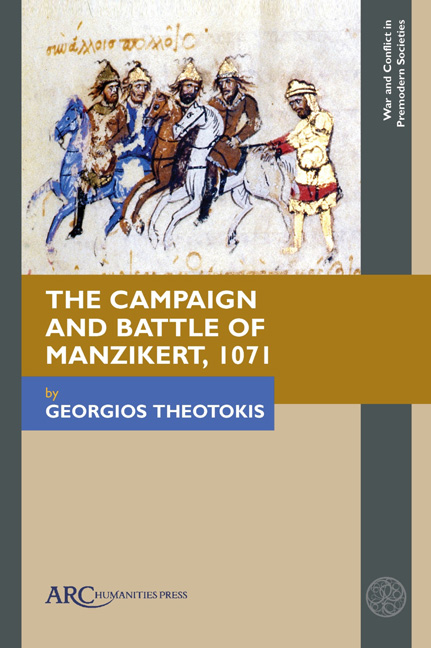Book contents
- Frontmatter
- Dedication
- Contents
- List of Illustrations
- Introduction
- Chapter 1 Christian and Muslim Sources for the Battle of Manzikert: Making Sense of the Professional and Cultural Milieu
- Chapter 2 Christian and Muslim Sources for the Battle of Manzikert: Making Sense of the “Battle-Piece"
- Chapter 3 Christian and Muslim Sources for the Battle of Manzikert: Making Sense of Numbers and Local Topography
- Chapter 4 The Geopolitical and Military Background to the Battle of Manzikert
- Chapter 5 The Prelude to the Battle of Manzikert
- Chapter 6 The Battle of Manzikert
- Chapter 7 The Aftermath of the Battle of Manzikert
- Conclusions
- Select Bibliography
- Index
Chapter 2 - Christian and Muslim Sources for the Battle of Manzikert: Making Sense of the “Battle-Piece"
Published online by Cambridge University Press: 08 May 2024
- Frontmatter
- Dedication
- Contents
- List of Illustrations
- Introduction
- Chapter 1 Christian and Muslim Sources for the Battle of Manzikert: Making Sense of the Professional and Cultural Milieu
- Chapter 2 Christian and Muslim Sources for the Battle of Manzikert: Making Sense of the “Battle-Piece"
- Chapter 3 Christian and Muslim Sources for the Battle of Manzikert: Making Sense of Numbers and Local Topography
- Chapter 4 The Geopolitical and Military Background to the Battle of Manzikert
- Chapter 5 The Prelude to the Battle of Manzikert
- Chapter 6 The Battle of Manzikert
- Chapter 7 The Aftermath of the Battle of Manzikert
- Conclusions
- Select Bibliography
- Index
Summary
THE MAIN AIM of this chapter is to examine the primary sources for the Battle of Manzikert strictly from a military perspective and attempt to reach some conclusions regarding their value for the history of eleventh-century warfare in the region of Asia Minor. The major questions that will be raised in this chapter are: how accurate and detailed are their descriptions of pitched battles and clashes between enemy units during the Byzantine campaigns of 1068 to 1071 in the East? How far do their narratives permit an accurate reconstruction of chains of events, especially regarding the battlefield manoeuvres of armies in action?
The “Battle-Piece”
Why do historians write “battle-pieces”? And how should a modern reader attempt to understand the narrative of such a dramatic and complex event? Examining what a battle narrative can tell us and how to read it should be a central part of our approach to military history. But first, what is a “battle-piece”? We could say that it is the battle account that forms the essential element in the warfare narrative; a literary piece that was incorporated into hagiographies, letters, rhetorical works, epic poetry, romances, and, of course, historical texts. Yet, what remains unclear in the aforementioned definition is the perspective from which the battle narrative is written. Because the vast majority of the battle narratives from ancient to early modern times focus on events from the perspective of the commander(s) who inevitably had a disproportionate influence on the course of events, modern scholars have followed the same well-trodden course of writing about battles, adopting a traditional “command-centred” approach to the strategic, operational, and tactical movements of armies, where the thoughts, decisions, and actions of the commander(s) are far more visible than those of the common soldier(s).
Accordingly, one of the toughest challenges involved in writing about medieval warfare is describing what battle in that period “was really like”: how it might have felt to be there, including not just the physical but also the emotional sensations. What would have been running through the combatants’ minds? What were the motivations used to suppress their primal instinct for running away from danger?
- Type
- Chapter
- Information
- The Campaign and Battle of Manzikert, 1071 , pp. 23 - 62Publisher: Amsterdam University PressPrint publication year: 2024

